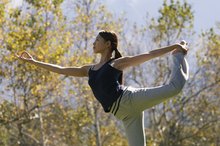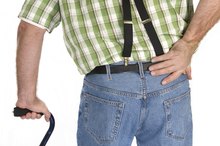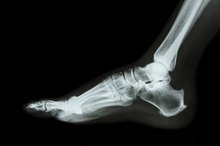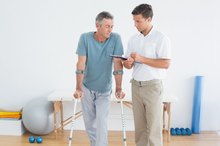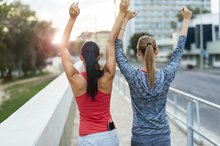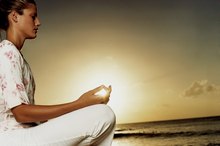Factors of Body Equilibrium & Balance
Factors that affect equilibrium and balance in the body include breathing, vision, vestibular function, musculoskeletal alignment and proprioception. The eyes, vestibular system and proprioceptors of the neck read and adjust head placement in relation to the environment. The respiratory system, the musculoskeletal system and the proprioceptors of the feet and body influence the stability and equilibrium of the rest of the body.
Breathing
Breathing affects body equilibrium and balance in a number of ways. Relaxed deep breathing provides oxygen necessary for brain function and interaction with the sense organs that detect equilibrium and balance. Blockages in the nasal passageways may create spinal misalignment as the head shifts forward to open the airways. Tense diaphragm and/or abdominal muscles limit breathing to the upper lungs. This causes the center of gravity to shift the upper chest and the body to become top-heavy.
- Breathing affects body equilibrium and balance in a number of ways.
- This causes the center of gravity to shift the upper chest and the body to become top-heavy.
Vision
How Does Exercise Improve Your Posture?
Learn More
Through peripheral and ambient vision, the brain senses the body’s movement, orientation in space and relationship to objects in the environment. Vision also detects the stability of a surface or object. For example, seeing a swaying rope bridge causes a different response in the body than seeing a sturdy pillared one. When the eyes focus on a steady object, the vestibular system of the inner ear can orient the head vertically, horizontally and spatially. This helps stabilize the body.
- Through peripheral and ambient vision, the brain senses the body’s movement, orientation in space and relationship to objects in the environment.
- When the eyes focus on a steady object, the vestibular system of the inner ear can orient the head vertically, horizontally and spatially.
Vestibular Function
The vestibular system includes the organs within the inner ear. It coordinates with the visual and auditory systems to sense direction and speed of head movement. A fluid called endolymph flows through the three canals of the inner ear as the head tilts and shifts. Tiny hairlike cells send impulses to the brain as the endolymph bends each hair. Disorders of vestibular function can cause vertigo or difficulty balancing on unstable surfaces. Dehydration, food allergies and head/neck trauma can cause vestibular dysfunction.
- The vestibular system includes the organs within the inner ear.
- A fluid called endolymph flows through the three canals of the inner ear as the head tilts and shifts.
Musculoskeletal Alignment
Limping & Back Pain
Learn More
Balance within muscle groups and alignment of the skeletal system affect body equilibrium and balance. Small shifts of bones can affect the whole skeletal system. When the bite of the jaw is off or one leg is longer than the other, the entire spine compensates for the misalignment. Opposing muscle groups stabilize the joints of the body through the balance of strength and tension. If one muscle is tight and its opposite is weak, the joint is pulled in the direction of tightness.
- Balance within muscle groups and alignment of the skeletal system affect body equilibrium and balance.
- Opposing muscle groups stabilize the joints of the body through the balance of strength and tension.
Proprioception
Proprioceptors are reflexive organs within muscles and tendons that response to changes in position of the body or limbs. Muscle spindles cause contraction of muscle fibers in response to these changes. Golgi tendon organs cause the tendons to lengthen. The most sensitive areas of proprioception are the neck and the feet. The proprioceptors of the neck work with the vestibular system to adjust head position. Proprioceptors of the feet spread or contract the toes or roll the bones of the feet laterally to keep the body upright.
- Proprioceptors are reflexive organs within muscles and tendons that response to changes in position of the body or limbs.
- The proprioceptors of the neck work with the vestibular system to adjust head position.
Related Articles
Resources
Writer Bio
Based in Washington, D.C., Jen Young is a certified personal trainer, performer and writer. She has written various articles for the PBS Adult Learning Service website. Young holds a Bachelors of Arts in radio, television and film from University of Southern Mississippi.
